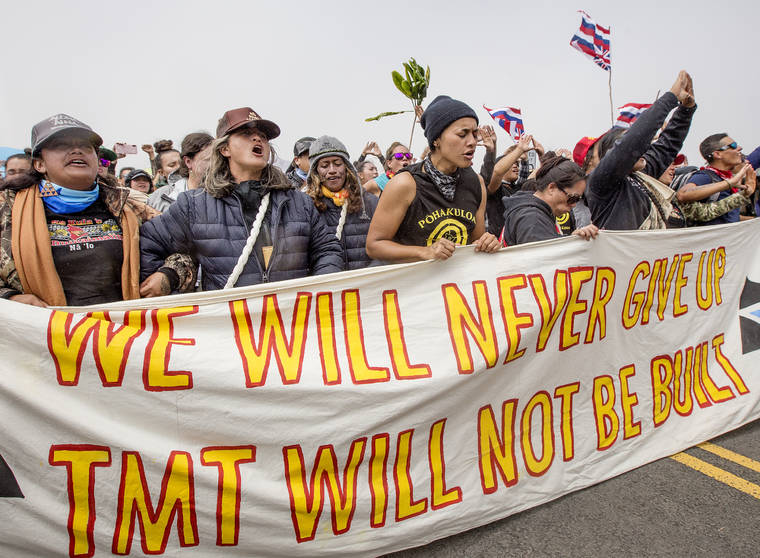Tour guides feeling the pinch of Maunakea closure
HILO — The closure of Maunakea and uncertainty about the status of Saddle Road is having a direct impact on the island’s tour guides — primarily mom and pop operations that rely on stargazing and astronomy tours to make their living.
“We are collateral damage of a larger game,” said Doug Arnott, whose Arnott’s Lodge &Hiking Adventures is one of eight companies with permits to conduct Maunakea tours. “Yes, it’s impacting us dreadfully and we’re stoically waiting this out.”
Tour guides are among those taking the biggest financial hit from the weeklong closure of the Mauna Kea Access Road as hundreds protest the coming construction of the Thirty Meter Telescope. On Tuesday, 25 scientists from five observatories were evacuated.
But that doesn’t mean the Maunakea support staff, charged with maintenance, cleaning, cooking and protecting cultural and natural resources, are out of work. Far from it.
In fact, there are more people staying at the Onizuka Center for International Astronomy, also known as Hale Pohaku, than before, as law enforcement personnel are bunking in the facility, which houses 72 people.
“It’s full right now,” said Daniel Meisenzahl, a spokesman for the University of Hawaii. “It’s all hands on deck.”
The tour companies haven’t been able to access the mountain since Monday, and the immediate future is unknown. Arnott said his lodging establishment had just started picking up from the post-eruption slowdown that started last year, and then this happened.
Tours associated with the island’s cruise ship industry are helping keep their employees working, but several tour owners said their workers worked fewer hours or made less money because they weren’t driving the Maunakea route.
Others have had to limit their tours because of the uncertainty of possible road closures, such as happened Wednesday. Although Saddle Road wasn’t closed for long, not knowing when it would be open made it more difficult to plan, tour guides said.
“Some because their tour is canceled lost work,” said Chris Paterson, owner of Kailani Tours, who isn’t one of the eight Maunakea tour guides but does traverse Saddle Road. “These things happen and it’s just part of it. … It’s important to be nimble in this business.”
Henry Wang, part owner and manager of Super Vacation Hawaii LLC, had to cancel several tours, but the company is still booking for next week.
“We just won’t be able to see the stars. … There’s no tour, so there’s no work,” Wang said. “We’re just waiting for the news.”
Every day off the mountain is a big financial hit, noted Arnott. Each passenger in a 14-passenger van pays about $180-$220. The Maunakea license allows each operator two vans a day. Taking a van of 12 people at a rate of $200, it means in the past four days alone, an estimated $153,000 in tourist dollars was lost on the mountain.
Puna Councilman Matt Kanealii-Kleinfelder worries the county is bearing the cost of road closures and police activities on the mountain. Kanealii-Kleinfelder said he’s been at the Mauna Kea Access Road site four of the past five days, and saw no evidence of anything but aloha from those opposing TMT construction.
He’s given the administration until Aug. 6 to provide a summary of expenses the county has incurred to date. The update will be part of the Finance Committee agenda, he said.
“The unannounced closures of our highway were both premeditated, unnecessary and caused undue stress on county residents and visitors,” Kanealii-Kleinfelder said Thursday in a press release. “There was no emergency that warranted shutting down the Daniel K Inouye Highway to date. There was no reason to invoke a State of Emergency to date.”
Mayor Harry Kim has said the state will reimburse the county for its expenses. But Kanealii-Kleinfelder didn’t see Gov. David Ige clearly committing to that in a recent press conference. Either way, Kanealii-Kleinfelder said, the group building TMT said in a recent Honolulu Star-Advertiser article that it’s not paying.
“The taxpayer will not be reimbursed,” he said. “No matter how you look at it, if they pay for it at the state or county level, the taxpayer will pay for it.”


